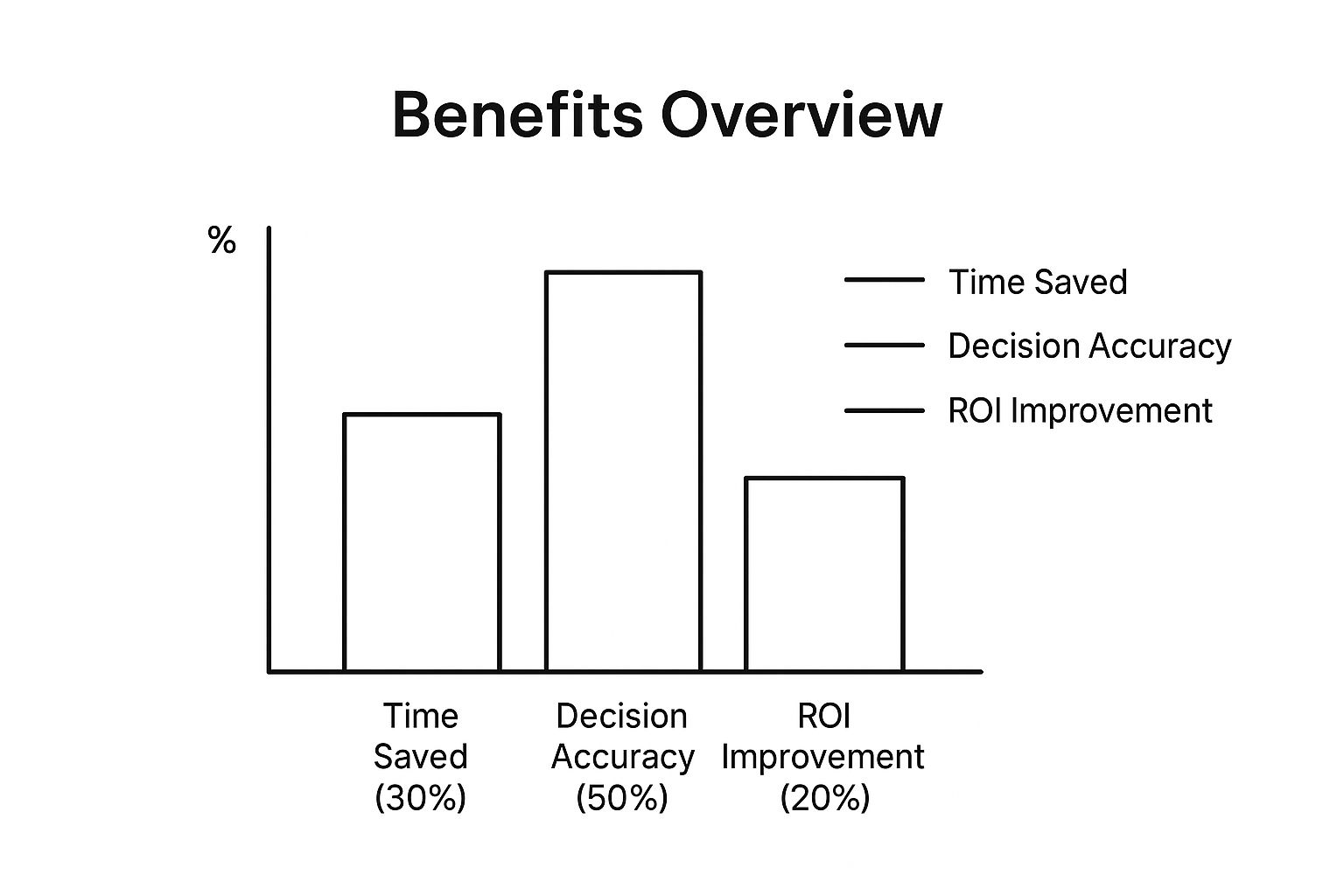
Project Prioritization Matrix: Make Smarter Decisions
Share
Understanding the Power of Project Prioritization Matrices

In today's business world, efficient project management is essential. With limited resources, choosing the right projects is critical. Project prioritization matrices offer a structured way to make these decisions strategically, moving beyond intuition. They help teams evaluate competing projects and align them with company goals. For example, a startup might prioritize quick wins to attract investors, while a larger company might focus on long-term strategies.
Project prioritization matrices are visual tools that help teams objectively assess projects based on set criteria. This offers a more detailed evaluation than a simple yes or no, leading to better resource allocation. This structured approach is especially important in high-stakes environments. These matrices are key for strategic planning and resource management. The Eisenhower Matrix, which categorizes tasks by urgency and importance, is a classic example. By 2020, over 70% of organizations used a prioritization matrix, highlighting their widespread use. Learn more about prioritization matrices here.
Key Benefits of Using a Project Prioritization Matrix
Using a project prioritization matrix provides numerous advantages:
-
Improved Resource Allocation: Identifying high-priority projects helps organizations allocate resources like time, budget, and staff more effectively.
-
Increased Project Success Rates: Prioritization reduces the risk of pursuing less valuable projects, boosting overall success rates. Some studies show increases of up to 20%.
-
Enhanced Strategic Alignment: Matrices ensure projects contribute to the organization's strategic goals.
-
Better Decision-Making: They offer a clear, objective framework for decisions, minimizing bias and building team consensus.
-
Improved Transparency and Communication: The visual format promotes better communication and transparency around project selection and resources.
These benefits create tangible results, making project prioritization matrices a valuable tool for any organization seeking efficiency and project success. This structured approach directs limited resources towards initiatives with the highest return and biggest contribution to long-term goals. Choosing the right matrix for your specific needs and objectives is the next step.
Choosing The Right Matrix For Your 2x2 Decision Challenge
Not all project prioritization matrices are created equal. Each has its own strengths and weaknesses, making some a better fit for certain situations than others. Understanding these differences is key to maximizing the effectiveness of your prioritization efforts. This section breaks down the most effective frameworks, from the simple 2x2 Urgent/Important matrix to more sophisticated models like RICE (Reach, Impact, Confidence, and Effort) and weighted scoring systems.
Understanding The Core Matrix Types
The 2x2 matrix, popularized by Dwight D. Eisenhower, quickly categorizes tasks based on urgency and importance. It’s excellent for individual time management, helping you focus on what truly matters. However, for complex projects, its simplicity can be a limitation. You might be interested in: How to master...
For more complex projects, the RICE scoring model offers a more nuanced approach. By considering Reach, Impact, Confidence, and Effort, it provides a more data-driven prioritization. This is particularly useful when multiple stakeholders are involved and decisions require data justification.
Weighted scoring systems allow even greater customization. They enable you to assign weights to different criteria based on your specific strategic objectives. For example, a company focused on market share might assign a higher weight to “reach” than a company focused on profitability.
Matching Matrix To Business Challenge
Choosing the right project prioritization matrix depends heavily on your specific business challenge. Startups, often working with limited data and tight deadlines, might benefit from simpler models like the 2x2 matrix for quick decision-making.
Conversely, large enterprises managing complex initiatives across multiple divisions may need the comprehensive analysis offered by models like RICE or weighted scoring.

The infographic above visualizes the potential benefits of using a project prioritization matrix. It showcases improvements in time saved (30%), decision accuracy (50%), and ROI (20%). These improvements demonstrate the impact of a structured prioritization process. The boost to decision accuracy underscores how these matrices help mitigate the risk of biased decision-making.
To further illustrate the differences between these prioritization methods, let's examine a comparison table:
Introducing a comparison of common project prioritization matrix types helps to clarify the strengths and weaknesses of each model. This table will outline key features, ideal applications, and complexity levels to aid in selection.
| Matrix Type | Key Features | Best For | Complexity Level | Example Scenario |
|---|---|---|---|---|
| 2x2 Urgent/Important | Simple, fast, focuses on urgency and importance | Individual task management, quick decisions | Low | Prioritizing daily tasks, quick triage |
| RICE Scoring | Data-driven, considers reach, impact, confidence, and effort | Product development, larger projects | Medium | Prioritizing features in a software release |
| Weighted Scoring | Highly customizable, allows weighting of different criteria | Strategic decision-making, complex projects | High | Selecting a new market to enter |
The table above provides a concise overview of various project prioritization matrices. The 2x2 matrix excels in simplicity, RICE scoring offers data-driven insights, and weighted scoring provides maximum flexibility for complex scenarios.
Adapting Frameworks For Strategic Alignment
Leading teams don’t just adopt a matrix blindly; they adapt it. This means tailoring criteria and weights to reflect their unique strategic priorities. This customization allows for a dynamic prioritization process.
Decisions remain aligned with overarching business goals even as market conditions shift. This flexibility is essential for remaining agile and competitive. By carefully selecting and adapting the right framework, organizations create an actionable roadmap for project success.
Crafting Your Custom Project Prioritization Framework

Building a project prioritization matrix isn't simply about selecting a pre-existing template. It's about crafting a framework that specifically addresses your organization's unique needs and strategic objectives. This process begins with actively engaging key stakeholders. Their invaluable input ensures the matrix accurately reflects the organization's overall goals and priorities. This collaborative approach is essential for building consensus from the very beginning.
Defining Evaluation Criteria
Choosing the right evaluation criteria is paramount. These criteria should directly correlate with your strategic objectives. For example, if market expansion is a primary objective, "potential market size" becomes a crucial criterion. Similarly, if innovation is a core focus, "degree of innovation" should be given significant weight. This focused approach ensures the matrix aligns project selection with your overall business strategy.
Consider incorporating both quantitative and qualitative factors into your evaluation. Quantitative metrics, such as ROI and resource requirements, offer objective data. Qualitative factors, like strategic alignment and risk profile, add essential context and nuance. Balancing these perspectives creates a more robust and well-rounded evaluation process. This balanced approach appeals to both data-driven and intuitive decision-makers.
Creating a Scoring System
Your scoring system must be clear, consistent, and easy to understand. This promotes transparency and minimizes potential bias. A simple numerical scale (1-5) can be highly effective, especially when clear definitions are provided for each score. Weighted decision matrices offer a structured approach to enhance decision-making. Learn more about weighted decision matrices here. A recent study found that as of 2023, 80% of project managers utilize weighted decision matrices to effectively balance multiple criteria. This has led to a notable 25% reduction in project failure rates.
Weighting Criteria Effectively
Not all criteria hold equal importance. Weighting criteria allows you to emphasize factors most crucial to achieving your strategic goals. For example, if customer satisfaction is paramount, it should be assigned a higher weight than less critical factors. This ensures the matrix prioritizes projects with the greatest potential impact on your key objectives.
You might be interested in: How to master...
Avoiding Common Pitfalls
Several potential pitfalls can hinder the effectiveness of your project prioritization matrix. One common mistake is over-reliance on subjective opinions. Another is failing to regularly update the matrix to reflect evolving business needs. By proactively addressing these challenges, you can maintain the credibility and effectiveness of your framework over time.
Ensuring Transparency and Buy-In
Transparency is crucial for fostering trust and securing buy-in from stakeholders. Clearly document the rationale behind criteria selection and weighting. This open communication helps prevent misunderstandings and builds confidence in the prioritization process. Regular review cycles ensure the matrix remains relevant as strategic objectives change. This ongoing refinement is key to ensuring the framework continues to deliver value. By establishing a well-defined and transparent process, you create a powerful tool for driving strategic alignment and ultimately, achieving project success.
From Theory to Practice: Implementing Your Matrix
A well-designed project prioritization matrix is only effective if properly implemented. This involves addressing the practical considerations of rolling it out across teams, managing competing interests, and overcoming resistance to change. Successful implementation requires careful planning and execution.
Gathering Accurate Project Data
The foundation of any effective project prioritization matrix is accurate data. This means gathering reliable information on factors like projected Return on Investment (ROI), resource requirements, and potential risks. Inaccurate cost estimations, for example, can lead to misallocation of resources. Involving stakeholders early in the data collection process ensures buy-in and improves accuracy. This collaborative approach creates a shared understanding of project requirements and priorities.
Facilitating Productive Discussions
Prioritization discussions can be challenging, particularly when resources are limited. Facilitating productive conversations is crucial. Clearly defined criteria and a transparent scoring system keep discussions objective and data-driven. This reduces the influence of personal biases and promotes fair decision-making. Establishing ground rules for respectful communication helps ensure everyone feels heard.
Maintaining Scoring Consistency
Consistency in scoring is essential for a fair and reliable process. Developing clear scoring guidelines and training evaluators minimizes variations in interpretation. This standardized approach ensures all projects are evaluated using the same criteria, promoting objectivity. Regularly reviewing and calibrating the scoring system maintains consistency over time. For further insights, check out this resource: How to master…
Building Stakeholder Buy-In
Resistance to change is common when implementing new processes. Building genuine buy-in from stakeholders, especially those whose projects may be deprioritized, is essential. Openly communicating the benefits of the matrix and addressing concerns fosters trust and encourages acceptance. Involving stakeholders in the design and implementation phases increases their ownership and reduces resistance, promoting successful adoption.
Documenting Decisions and Establishing Review Cycles
Transparency builds trust and accountability. Documenting decisions and the rationale behind them creates a clear audit trail. This documentation is invaluable for future reference and justifying resource allocation. Establishing regular review cycles, such as quarterly or annually, ensures the matrix stays relevant as business needs and strategic objectives change. This ongoing review process maintains the effectiveness of the prioritization framework, ensuring long-term success.
Measuring the Business Impact of Smart Prioritization

Moving beyond a subjective sense of organization, how can businesses objectively measure the success of their project prioritization matrix? The answer lies in tracking key metrics directly linked to business outcomes. Leading organizations recognize that effective prioritization isn't just about completing tasks; it's about generating tangible results and demonstrating real value.
Quantifying the ROI of Prioritization
A critical aspect of measuring prioritization success is determining the Return on Investment (ROI). This involves analyzing improvements in resource allocation, project success rates, and strategic alignment. For example, has implementing a matrix reduced the number of projects delivered late or exceeding budget? Such demonstrable improvements clearly illustrate the matrix's positive impact.
Analyzing the relationship between prioritization and financial performance is also essential. The use of project prioritization matrices offers substantial financial benefits. For instance, after implementing a prioritization matrix, nearly 60% of B2B SaaS companies reported increased revenue and an average annual growth rate of 12%. More detailed statistics can be found here. Furthermore, concentrating on high-priority projects allows for better resource allocation, potentially saving up to 15% of project budgets.
To further illustrate the ROI of project prioritization matrices, let's examine some statistical data across various industries:
Introduction to ROI Table: The following table showcases the positive impact of implementing project prioritization processes on key business metrics across different sectors.
| Industry | Revenue Impact (%) | Cost Savings (%) | Project Success Rate Improvement (%) | Resource Utilization Increase (%) |
|---|---|---|---|---|
| Software Development | 15 | 12 | 20 | 8 |
| Manufacturing | 8 | 10 | 15 | 5 |
| Healthcare | 10 | 7 | 18 | 6 |
| Financial Services | 12 | 9 | 22 | 7 |
| Marketing & Advertising | 18 | 11 | 25 | 9 |
Key Insights from ROI Table: As the table demonstrates, project prioritization leads to significant improvements across all measured metrics. The impact is particularly notable in Marketing & Advertising and Software Development, showcasing the potential of prioritization to drive substantial business growth.
Tracking Key Performance Indicators
To gain deeper insights, consider implementing a framework to track relevant Key Performance Indicators (KPIs). These KPIs could include:
- Resource Utilization: Ensuring resources are allocated to the most impactful projects.
- Project Success Rates: Monitoring on-time and within-budget project completion rates.
- Strategic Alignment: Evaluating how effectively completed projects contribute to strategic goals.
- Revenue Growth: Analyzing the revenue generated by prioritized projects.
By closely monitoring these metrics, businesses can gain a clear understanding of their project prioritization matrix's effectiveness. You might be interested in: How to master...
Refining Criteria and Scoring
Data-driven decision-making is essential for continued success. Analyzing outcome data allows for informed adjustments to criteria weights and scoring methodologies. This continuous refinement ensures the project prioritization matrix remains dynamic and adaptable to the evolving strategic objectives of the organization.
Case Studies and Best Practices
Learning from the experiences of other organizations can provide valuable insights. Case studies from different industries offer a glimpse into how successful businesses measure the impact of prioritization. These real-world examples can inspire practical approaches and highlight innovative strategies for maximizing prioritization efforts and identifying applicable best practices.
Overcoming Common Prioritization Pitfalls
Even with a well-structured project prioritization matrix, challenges can arise. This section addresses these common obstacles and offers practical solutions from experienced project leaders. These insights will help you navigate the complexities of prioritization and maintain a reliable process.
Dealing With Incomplete Data
One common hurdle is incomplete data. It’s unrealistic to expect perfect information for every project. However, sound decisions require a solid foundation.
One strategy is to conduct a sensitivity analysis. This involves testing how different data assumptions affect the prioritization outcome.
If small changes drastically alter the rankings, it highlights areas where more data is needed. Alternatively, incorporating a risk assessment into the matrix can account for uncertainty. Assigning higher risk scores to projects with limited information compensates for potential unknowns.
Managing Conflicting Stakeholder Priorities
Another challenge is managing conflicting stakeholder priorities. Different departments often have competing interests. Sales might prioritize quick wins, while engineering focuses on long-term stability.
Facilitating open communication is key. A workshop where stakeholders discuss their priorities and the rationale behind them fosters mutual understanding.
This collaborative approach helps build consensus. The matrix itself becomes a tool for transparently negotiating trade-offs.
Preventing Score Manipulation
Score manipulation can undermine the integrity of the entire process. If stakeholders feel pressured to inflate scores for their favored projects, the matrix loses credibility.
One solution is to establish clear scoring guidelines with detailed descriptions for each level. This reduces ambiguity and promotes consistent evaluation.
Additionally, having multiple independent evaluators can mitigate bias.
Adapting to Rapidly Changing Environments
In today’s dynamic business environment, requirements change quickly. A static project prioritization matrix quickly becomes outdated.
Building in flexibility is critical. One approach is to establish regular review cycles, perhaps quarterly, to reassess priorities and adjust criteria. This allows the matrix to adapt to evolving market conditions and strategic shifts.
Maintaining Matrix Credibility
Even with the best intentions, political pressures from powerful stakeholders can threaten the credibility of the matrix. Transparency is the best defense.
Documenting the rationale behind criteria selection and weighting builds trust. Openly communicating how scores are calculated and decisions are made removes the perception of favoritism.
This promotes confidence in the process, even under pressure.
By understanding these potential pitfalls and implementing these practical solutions, you can ensure your project prioritization matrix remains a reliable and effective tool for making smart decisions. This proactive approach sets the stage for consistent, trustworthy results.
Ready to take control of your projects and boost your productivity? The Boss Personal Planner offers a comprehensive digital and physical planning solution to help you achieve your goals. It simplifies goal-setting, task management, and productivity enhancement with tools for habit tracking and schedule organization. Visit Boss Personal Planner today and transform your chaotic schedule into structured success.
